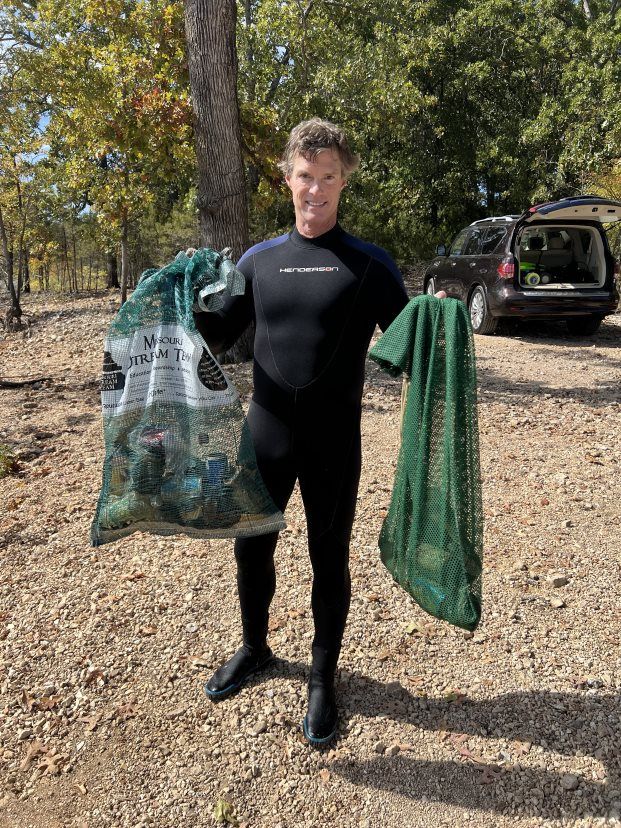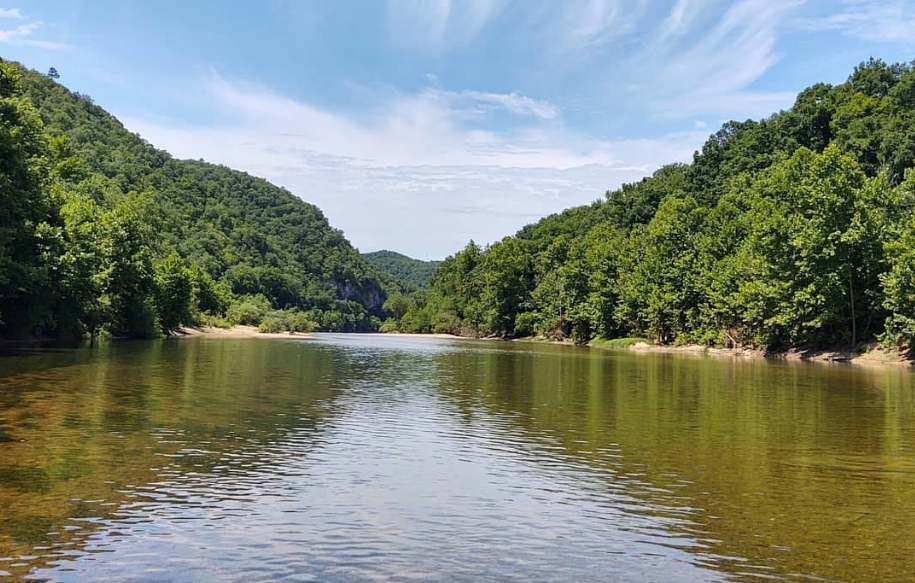
Community Science at Work: StreamSmart Volunteers Monitor War Eagle Creek’s Health
Cleaner Water Together
This story continues our series on the StreamSmart volunteer water monitoring program. If you missed the first article, you can find it here.
Many of us know War Eagle Creek for its scenic bluffs, historic mill, famous craft fair, and beloved outdoor recreation opportunities. But did you know that War Eagle Creek is also one of the largest tributaries leading to Beaver Lake, the drinking water source for over 500,000 people in Northwest Arkansas? The stream can have a significant impact on the lake’s water quality. Given its importance, StreamSmart volunteers have been monitoring 6 sites on and around War Eagle Creek since 2013 (figure 1).
StreamSmart Monitoring Sites in Beaver Lake Watershed

In 2022, the Arkansas Division of Environmental Quality (ADEQ) added War Eagle Creek to its 303d list of impaired waterways for low dissolved oxygen (DO). That might sound technical, but think of DO as the breathable air for fish, mussels, and other aquatic life. When oxygen levels drop too low, these animals struggle to survive.
Low DO often happens when excess nutrients like nitrogen and phosphorus enter waterways and cause excess algal growth. This might be counterintuitive if you remember that algae are photosynthetic and actually produce oxygen—but this is when sunlight is available. Algae decompose as well, and it’s this process that sucks oxygen out of the water.
So, are nutrients increasing and affecting DO? If so, where are they coming from? This is where our StreamSmart volunteers make a difference! Their data help tell the story of what’s happening in War Eagle Creek.
Volunteers are Picking up the Signals
Our StreamSmart volunteers monitor six sites in the War Eagle Creek subwatershed. While one site is on WEC itself, the other five sites are on smaller tributaries that flow into WEC. Monitoring tributaries can help pinpoint where nutrients are coming from and where solutions can have the biggest impact. Data collected by StreamSmart volunteers provides a clearer picture of the watershed so people can focus attention on where it’s needed most.
Nutrient concentrations have been steadily increasing over the last decade at some of the sites. Trends in nitrogen concentrations are increasing at Holman Creek, Clear Creek, and Glade Creek. In fact, at Glade Creek, concentrations have almost doubled from around 2.5 mg/L to almost 5 mg/L during this time frame (graph 1).
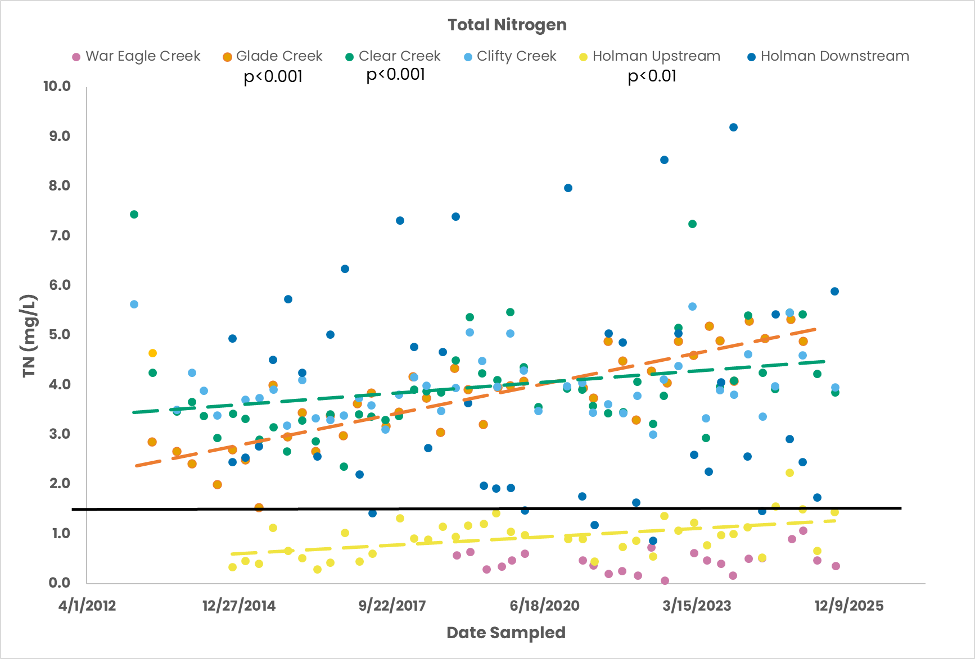
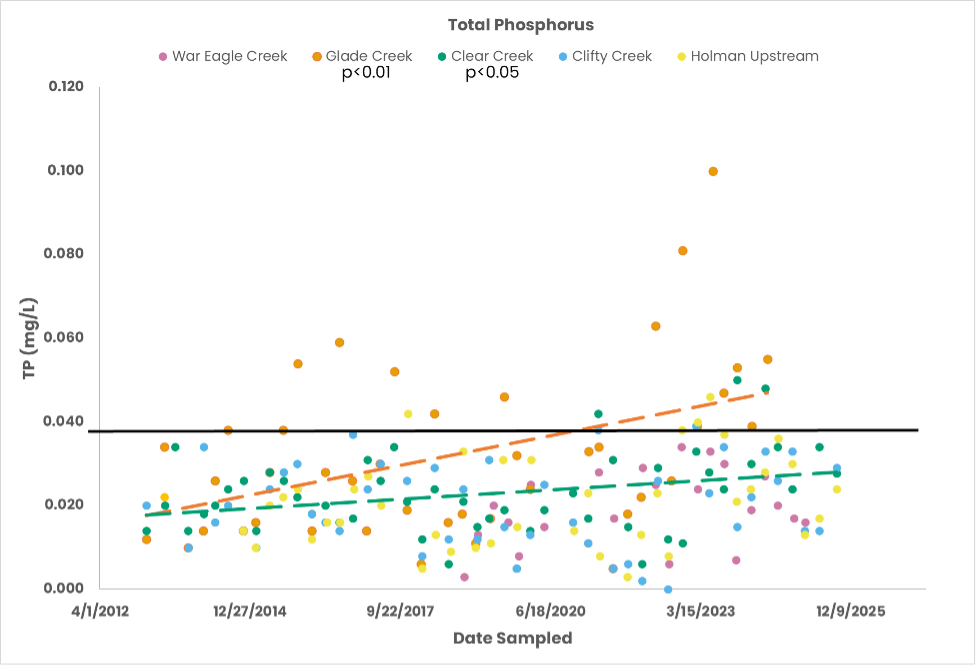
Trends in phosphorus concentrations are increasing at Clear Creek and Glade Creek. Again, concentrations at Glade Creek have seen a dramatic increase from about 0.020 mg/L to 0.040 mg/L, with some values as high as 0.100 mg/L. Concentrations and trends like these for nitrogen and phosphorus can signal excessive nutrient enrichment that can drive algal growth, resulting in drops in DO¹ ².
What “Impairment” Really Means
When states like Arkansas and Missouri evaluate water quality in streams and rivers, they do so in terms of the waterways’ designated uses, such as supporting aquatic life, recreation, or drinking water supply. A hub for folks who love to fish, War Eagle Creek must support aquatic life, which includes meeting minimum DO standards.
When ADEQ listed War Eagle Creek as impaired, it didn’t mean the river was ruined, just that it wasn’t consistently meeting the DO levels needed to support the fish and other organisms that depend on it. With this designation comes a call to action – something in the watershed is changing enough to put aquatic life at risk, and we need information to understand what’s causing this and how we can fix it.
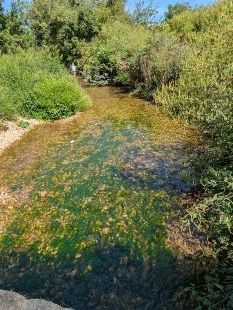
Seeing the Whole Watershed
StreamSmart volunteers may not be professionals by trade, but these citizen scientists are doing real, valuable science. The data they collect fills gaps, provides greater detail, and paints a clearer picture of the health of the watershed as a whole. These high-resolution data show hotspots of nutrient pollution that other agencies aren’t capturing, providing water managers with the information needed to target solutions, track improvements, and support restoration work where it’s needed most.
Next month, we’ll end this series by hearing from the volunteers themselves: their motivations, their favorite experiences, and the reasons they return year after year to monitor their stream site. Follow our newsletter to learn more.
References
- Evans-White, M. A., Haggard, B. E., & Scott, J. T. (2013). A review of stream nutrient criteria development in the United States. Journal of Environmental Quality, 42(4), 1002–1014. https://doi.org/10.2134/jeq2012.0491
- Haggard, B. E., Grantz, E., & Scott, J. T. (2022). Defining critical or hydrologic conditions as sampled during the Joint Study (Technical Report MSC 393). Arkansas Water Resources Center.
Become a volunteer!
Want to protect Beaver Lake while spending time in some of Northwest Arkansas’s most beautiful places? Become a StreamSmart volunteer! We are seeking volunteers for our sites at Baldwin Creek and the White River near St. Paul.



